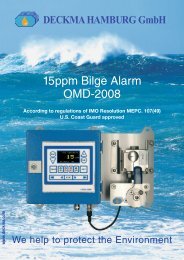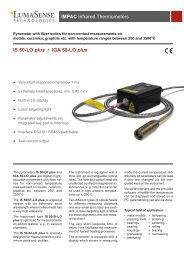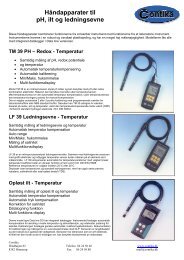Pyrometer- Handbook - Contika
Pyrometer- Handbook - Contika
Pyrometer- Handbook - Contika
Create successful ePaper yourself
Turn your PDF publications into a flip-book with our unique Google optimized e-Paper software.
The remaining part of incoming rays penetrate the object<br />
and are transmitted through it. We speak of transparent<br />
materials. This process too may be selective. While normal<br />
window glass lets all of the spectrum of visible light pass<br />
through, tinted sunglasses let only a certain part of the<br />
spectrum through.<br />
Every object has the above mentioned properties, but they<br />
are represented in different percentages according to the<br />
material under observation. They are described<br />
mathematically as reflection rate ρ, absorption rate α, and<br />
transmission rate τ. They refer to the ratio of reflected,<br />
absorbed, or transmitted intensity to the intensity of the<br />
incoming light. The values for ρ, α and τ lie between 0 and<br />
1 5). Their sum is always 1.<br />
With these values a black body's behavior may be<br />
theoretically described as one which absorbs all incoming<br />
rays. Its absorption coefficient, α, is 1 (one). It follows<br />
then that ρ = 0 (zero), and τ = 0 (zero).<br />
In thermal equilibrium, a body which absorbs well, emits<br />
well. (Robert Kirchhoff, 1824-1877). This means that its<br />
absorption coefficient α equals its emission coefficient ε.<br />
At a given temperature maximum flow of radiation come<br />
from black bodies.<br />
Therefore, this object is also called a black body radiation<br />
source. In practical terms this condition is evident in soot<br />
or in flat black colour.<br />
The emission coefficient ε is the relationship of the<br />
emission output of an object to the emission output of a<br />
black body radiation source at the same temperature. ε is<br />
influenced by the object's material and changes with the<br />
wavelength, the temperature or other physical values.<br />
5) one can also say, between 0% and 100%<br />
<strong>Pyrometer</strong> <strong>Handbook</strong><br />
transmission<br />
ρ: reflection rate<br />
α: absorption rate<br />
τ: transmission rate<br />
black bodies<br />
α = ε<br />
black body<br />
radiation source<br />
emission<br />
coefficient ε<br />
17

















